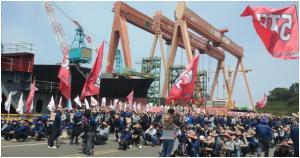
If the labor unions of Hyundai Heavy Industries Group’s three shipbuilding affiliates — Hyundai Heavy Industries Co., Hyundai Mipo Dockyard, and Hyundai Samho Heavy Industries — start a joint strike on Dec. 13 as announced, it will cost the group 9 billion won a day, analysts say.
The labor unions of the three companies plan to go on strike for four hours in the afternoon on Dec. 6. On Dec. 7, all union members will down tools for seven hours. On Dec. 13, all union members will walk away in an indefinite general strike.
The labor and management of Hyundai Heavy Industries have held 34 rounds of collective bargaining negotiations so far this year, but have not been able to settle differences. Recently, the management proposed a revised plan including a basic wage increase of 80,000 won, but the union is known to be demanding more than 100,000 won.
If unionists walk away, it will mark the first time since the foundation of HHI Group that the labor unions of the three affiliates go on strike together on the same day. As the unions stage the strike together, analysts forecast that the scale of the damage will be unprecedentedly large.
Previously, the unionists suspended their work in January and February and went on a partial strike for about 70 hours in April and May. At that time, Korea Shipbuilding & Offshore Engineering (KSOE), which controls the three shipbuilders, said that it suffered a loss of about 35.7 billion won due to a partial work suspension in the January-February period, and if the suspension of work in April-May is included, its annual sales loss would amount to about 100 billion won.
Average daily sales loss in a four-day strike in 2018 reached 8.35 billion won, according to the company’s estimate. During the strike, the total production loss amounted to about 35 billion won.
Compared to 2018, the shipyard utilization rate is higher now. According to Hyundai Heavy Industries Co.’s business report, the company’s average utilization rate in 2018 was 60.2 percent, but this year it rose to 63.2 percent. This means that if the general strike becomes a reality, the damage is likely to be larger than in 2018. A simple damage calculation based on the shipyard operation rate suggests that the average daily sales loss would amount to about 8.87 billion won.

